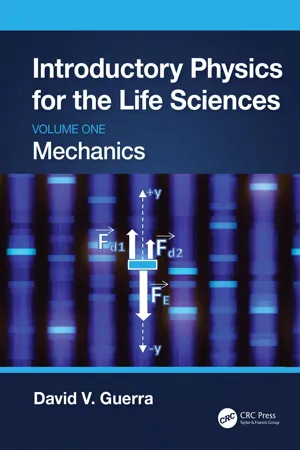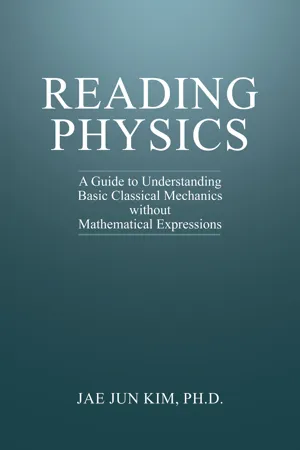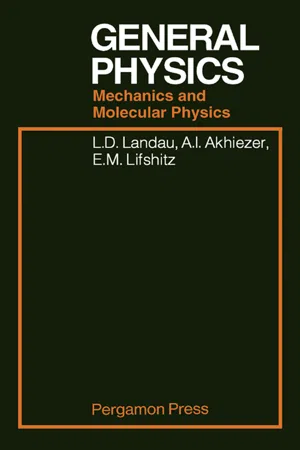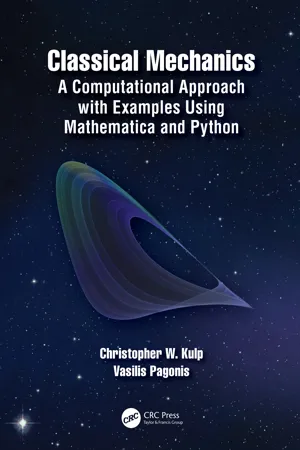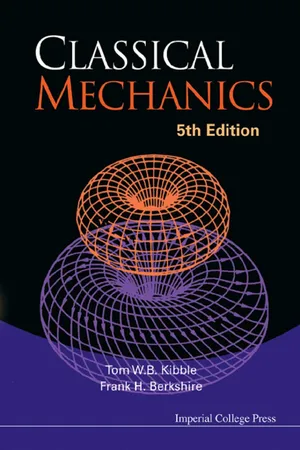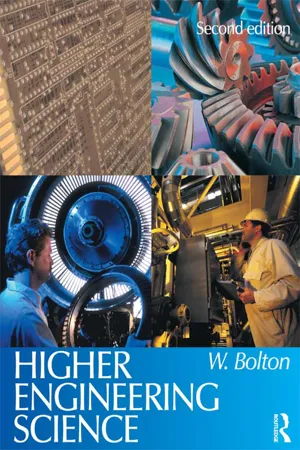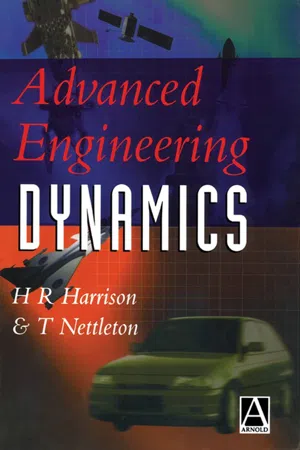Physics
Rotational Motion
Rotational motion refers to the movement of an object around an axis. It involves the rotation of an object, such as a wheel or a spinning top, and is characterized by angular displacement, velocity, and acceleration. This type of motion is governed by principles such as torque, angular momentum, and moment of inertia.
Written by Perlego with AI-assistance
Related key terms
11 Key excerpts on "Rotational Motion"
- David V. Guerra(Author)
- 2023(Publication Date)
- CRC Press(Publisher)
13 Rotational Motion
DOI: 10.1201/9781003308065-1313.1 Introduction
Rotational Motion is the motion of an object spinning around an axis that passes through the object itself. This is to be contrasted with translational motion, which is the motion of an object moving through space in a straight or curved path without rotation. As demonstrated in Figure 13.1 , a block sliding down an incline moves with only linear motion defined by a displacement, a velocity, and an acceleration. A disk rotating about a fixed axis moves with only Rotational Motion, but a ball rolling down an incline experiences both rotational and linear motion.FIGURE 13.1 Examples of different types of motion.As demonstrated in Chapter 12 , when an object is traveling in a circular path, the concepts of translation kinematics are commonly applied to the analysis, but sometimes the concepts of Rotational Motion, period, frequency, and angular frequency can be applied. So, circular motion provides a transition between the language of translational and Rotational Motion, which is formalized in this chapter. In addition, rotational dynamics will formalize the connection between the net rotational force, or net torque, on an object and the angular acceleration of the object.- Chapter question: There are bacteria that employ a rotating flagellum, tails that look a bit like a corkscrew, to propel themselves forward. In normal situations, these propulsion systems work well to move these bacteria forward through water. On the other hand, when a drop of water containing these bacteria is placed on a microscope slide, the bacteria begin to move in approximately circular paths at fairly constant speeds (Figure 13.2 ).
FIGURE 13.2
- eBook - ePub
Newtonian Dynamics
An Introduction
- Richard Fitzpatrick(Author)
- 2021(Publication Date)
- CRC Press(Publisher)
CHAPTER 8 Rotational MotionDOI: 10.1201/9781003198642-88.1 Introduction
Up to now, we have only analyzed the dynamics of point masses (i.e., objects whose spatial extent is either negligible, or plays no role in their motion). Let us now broaden our approach in order to take extended objects into account. The only type of motion that a point mass object can exhibit is translational motion; that is, motion by which the object moves from one point in space to another. However, an extended object can exhibit another, quite distinct, type of motion by which it remains located (more or less) at the same spatial position, but constantly changes its orientation with respect to other fixed points in space. This new type of motion is called rotation. Let us investigate Rotational Motion.8.2 Rigid Body Rotation
Consider a rigid body executing pure Rotational Motion (i.e., Rotational Motion that has no translational component). It is possible to define an axis of rotation (which, for the sake of simplicity, is assumed to pass through the body); this axis corresponds to the straight-line that is the locus of all points inside the body that remain stationary as the body rotates. A general point located inside the body executes circular motion that is centered on the rotation axis, and orientated in the plane perpendicular to this axis. In the following, we shall tacitly assume that the axis of rotation remains fixed.Figure 8.1 shows a typical rigidly rotating body. The axis of rotation is the line AB. A general point, P, lying within the body executes a circular orbit, centered on AB, in the plane perpendicular to AB. Let the line QP be a radius of this orbit that links the axis of rotation to the instantaneous position of P at time t. Obviously, this implies that QP is normal to AB. Suppose that at timet + δ tpoint P has moved to P′ , and the radius QP has rotated through an angleδ ϕ. The instantaneous angular velocity of the body,ω ( t ) - eBook - ePub
Reading Physics
A Guide to Understanding Basic Classical Mechanics without Mathematical Expressions
- Jae J. Kim(Author)
- 2023(Publication Date)
- Universal Publishers(Publisher)
Figure 31.2 illustrates the rotation motion with a curved arrow. The main point is this: whenever an object interacts with another physically, two types of motion are going to occur, a linear and a Rotational Motion. Both are going happen, not just one.So, coming back to you hitting a ball, the motion associated with the sphere is going to be a combination of the two: one that is parallel with respect to the direction of the applied force and one that is not. The former is what linear motion is about, and that is what we studied in the kinematics part. The latter is the “rotational” motion part. Just like the linear motion, you need to have a reference point with which the size of the motion can be quantified. For instance, the rotation is going to be described with respect to the center of the ball.In short, following the uncertainty principle, any object is going to gain both a linear and a Rotational Motion when an external force is applied. In addition, a major difference between the linear and the Rotational Motion is that the distance to the reference position is going to stay the same in a Rotational Motion. Think of a ball spinning around the center. For that reason, it would be more convenient for us to introduce another coordinate system when describing Rotational Motion. The distance stays the same, but the displacement is changing. That is where and why we introduce physical quantities such as angle and moment of inertia. We are going to go over that later.Figure 31.1: The objects in gray are a sphere and a rod that is about to go through the sphere. On the right-hand side, the rod is going through the sphere. Can anyone pierce through the sphere at the center with perfect precision if the true “center” is defined mathematically? Can anyone do that?Figure 31.2: This illustrates how the uncertainty principle works. There is a hypothetical point at which force is delivered and the object with a dimension is not going to gain Rotational Motion. If you hit the object at that position with perfect precision, then the object is not going to gain any Rotational Motion, hypothetically speaking. However, that is not what is going to happen. Following the uncertainty principle, we cannot hit that hypothetical point, the center, with perfect precision. For that reason, any object with dimension in the end is going to gain some Rotational Motion. It could be a very small amount though. - eBook - ePub
General Physics
Mechanics and Molecular Physics
- L D Landau(Author)
- 2013(Publication Date)
- Pergamon(Publisher)
P :v = r d φ / d t .The quantity dφ /dt is the same at every point of the body and is the angular displacement of the body per unit time. It is called the angular velocity of the body, and we shall denote it by Ω.Thus the velocities at various points in a rigid body rotating about an axis are given byv = r Ω ,where r is the distance of the point from the axis of rotation, the velocity being proportional to this distance.The quantity Ω in general varies with time. If the rotation is uniform, i.e. the angular velocity is constant, Ω can be determined from the period of rotation T :Ω = 2 π / T .A rotation is defined by the direction of the axis of rotation and the magnitude of the angular velocity. These may be combined by means of the angular-velocity vector Ω, whose direction is that of the axis of rotation and whose magnitude is equal to the angular velocity. Of the two directions of the axis of rotation it is customary to assign to the angular-velocity vector the one which is related to the direction of rotation by the “corkscrew rule”, i.e. the direction of motion of a right-handed screw rotating with the body.These simple forms of motion of a rigid body are especially important because any motion of a rigid body is a combination of translation and rotation. This may be illustrated by the example of a body moving parallel to a certain plane. Let us consider two successive positions of the body, A 1 and A 2 (Fig. 25 ). The body may evidently be brought from A 1 to A 2 in the following way. We first move the body by a translation from A 1 to a position A ′ such that some point O of the body reaches its final position. If we then rotate the body about O through a certain angle φ, it will reach its final position A 2 - eBook - ePub
- John Chiasson(Author)
- 2022(Publication Date)
- Wiley(Publisher)
Specifically, the Rotational Motion about an axis is caused by the applied tangential force and the further away from the axis of rotation that the tangential force is applied, the easier it is to get Rotational Motion. That is, the torque (cause of Rotational Motion) increases if either or increases, which corresponds to one's experience (e.g. opening doors). To summarize, is a vector pointing along the axis of rotation with its magnitude given by (Recall that the angular velocity vector also points along the axis of rotation where is the angular speed.) Let the external force act on the cylinder to move (rotate) it by a displacement. The change in work done on the cylinder by this force is then Dividing by, the power (rate of work) delivered to the cylinder is given by As the rate of work done equals the rate of change of kinetic energy, it follows that (5.2) or This gives the fundamental re lationship between torque and angular acceleration: (5.3) That is, the applied torque equals the moment of inertia times the angular acceleration. This is the basic equation for rigid body rotational dynamics about a fixed axis. Viscous Rotational Friction Almost always there are frictional forces, and therefore, frictional torques acting between the axle and the bearings. 2 This is illustrated in Figure 5.4. Figure 5.4 Viscous friction torque. Often the frictional force is proportional to the angular speed and this model of friction is called viscous friction, which is expressed mathematically as or, in scalar form, where is the coefficient of viscous friction. Sign Convention for Torque Suppose the axis of rotation is along the axis. The torque is where is the angle from to. The cross product has the component in the direction. Notice that direction of is perpendicular to both and. In engineering applications, the systems are designed so that the applied force is tangential to the Rotational Motion, i.e., so that - eBook - ePub
Classical Mechanics
A Computational Approach with Examples Using Mathematica and Python
- Christopher W. Kulp, Vasilis Pagonis(Authors)
- 2020(Publication Date)
- CRC Press(Publisher)
CHAPTER 11Rigid Body MotionWe begin this chapter by reviewing the Rotational Motion of a single particle around an arbitrary axis, and the concepts of the moment of inertia and the center of mass. In particular we focus on how the center of mass simplifies the description of the translational and Rotational Motion of a system of particles. After the review, we explore generalized definitions of the moment of inertia, including products of inertia and the inertia tensor, and we demonstrate how to calculate these quantities for a variety of solids. We will see that the moment of inertia tensor of a solid depends on the choice of the coordinate system. Furthermore, we will discuss the parallel axis theorem for rigid bodies and show how it can be used to calculate the moment of inertia tensor. This is followed by a discussion of eigenvalues and eigenvectors of matrices, and how they can be used to describe the principal axes of a rigid body. The chapter will conclude with a discussion of the Euler equations and how they can be used to describe the precessional motion of spinning tops and gyroscopes.11.1Rotational Motion of particles around a fixed axisIn this section, we will review Rotational Motion concepts that you likely learned in your introductory physics course. Here we will focus on the Rotational Motion of a particle that is confined to move in a circle of radius r in the xy-plane with an angular velocityω =, as illustrated in Figure 11.1ω zk ^ - No longer available |Learn more
- Robert A. Pelcovits, Joshua Farkas(Authors)
- 2023(Publication Date)
- Barrons Educational Services(Publisher)
The rotational inertia of any extended object, no matter how complex in shape, can be calculated in principle using the integral formulation, dividing the object up into pointlike constituents. Once the rotational inertia has been calculated for rotation about an axis, it can be easily recalculated for a second axis parallel to the first by using the parallel axis theorem.In analogy with linear momentum, the angular momentum of a rotating object can be defined and used to recast Newton’s second law for Rotational Motion. Angular momentum is conserved if the net external torque on a rotating object is zero. If an object is in static equilibrium, neither translating nor rotating, then both the net torque and force on the object must be zero.Practice Exercises
Multiple-Choice Questions
1 .A figure skater spins on the ice, holding two weights a distance d from the axis about which he is rotating (Figure 7.16 ). At a certain time, he pulls these weights toward his body as shown, causing his rotational inertia to decrease by a factor of 2. How does this affect the maximum speed with which any part of his body moves?Figure 7.16 (A)The maximum speed decreases by a factor of 2.(B)The maximum speed decreases by a factor of .(C)The maximum speed remains the same.(D)The maximum speed increases by a factor of .(E)The maximum speed increases by a factor of 2.2 .Consider the massless balance (which is at rest) shown in Figure 7.17 . What is the weight of m?Figure 7.17(A)m1(B)m1 g(C)m1 g cos θ(D)m1 g sin θ(E)m1 g sec θ3 .Consider a very thin rod with uniform density and total mass M lying along the x-axis as shown in Figure 7.18 . The rod’s rotational inertia about the y-axis is ML2 /12. The rod has the greatest rotational inertia when rotated about which axis?Figure 7.18(A)the y-axis(B)the x-axis(C)the vertical line x = L/4(D)the vertical line x = L/2(E)the horizontal line y = L/24 - eBook - ePub
- Tom W B Kibble, Frank H Berkshire(Authors)
- 2004(Publication Date)
- ICP(Publisher)
Chapter 5
Rotating Frames
Hitherto, we have always used inertial frames, in which the laws of motion take on the simple form expressed in Newton’s laws. There are, however, a number of problems that can most easily be solved by using a non-inertial frame. For example, when discussing the motion of a particle near the Earth’s surface, it is often convenient to use a frame which is rigidly fixed to the Earth, and rotates with it. In this chapter, we shall find the equations of motion with respect to such a frame, and discuss some applications of them.5.1Angular Velocity; Rate of Change of a Vector
Let us consider a solid body which is rotating with constant angular velocity ω about a fixed axis. Let n be a unit vector along the axis, whose direction is defined by the right-hand rule: it is the direction in which a right-hand-thread screw would move when turned in the direction of the rotation. Then we define the vector angular velocity ω to be a vector of magnitude ω in the direction of n: ω = ωn. Clearly, angular velocity, like angular momentum, is an axial vector (see §3.3 ).For example, for the Earth, ω is a vector pointing along the polar axis, towards the north pole. Its magnitude is equal to 2π divided by the length of the sidereal day (the rotation period with respect to the fixed stars, which is less than that with respect to the Sun by one part in 365), that isIf we take the origin to lie on the axis of rotation, then the velocity of a point of the body at position r is given by the simple formulaTo prove this, we note that the point moves with angular velocity ω around a circle of radius ρ = r sin θ (see Fig. 5.1 ). Thus its speed isFig. 5.1Moreover, the direction of v is that of ω ∧ r; for clearly, v is perpendicular to the plane containing ω and r - eBook - ePub
Introductory Physics
Summaries, Examples, and Practice Problems
- Michael Antosh(Author)
- 2023(Publication Date)
- CRC Press(Publisher)
Rotation Motion and ForcesDOI: 10.1201/9781003005049-99.1 Introduction: Rotational Motion is Like Linear Motion
Chapters 9 and 10 are about Rotational Motion, meaning things that rotate in a circle. Even though this motion looks different, you will see that the math is very similar to things we’ve done before.One example of this: instead of position being something that changes with motion, it is replaced with angle. Then, instead of velocity (how much the distance is changing with time), you will have an angular velocity, which is how much the angle is changing with time.We will end up repeating many of the things we have done before, including the equations from Chapter 2 that describe motion, and Newton’s second law from Chapter 4 . In a way, it will be like reviewing almost everything that we have already done.9.2 Units for Angle: Radians and Revolutions
The physics equations for rotation done in Chapters 9 and 10 will assume that the angles are in the unit of radians (rad). The unit conversion is:180 degrees = π radians(9.2.1)π is approximately equal to 3.14. Another unit for angle that is used often is revolutions (rev). The conversion is:360 degrees = 1 revolution(9.2.2)This conversion is because 1 revolution is the number of degrees in a full circle. You can combine Equations 9.2.1 and 9.2.2 to get a conversion between radians and revolutions:1 revolution = 2∙π radians(9.2.3)Example 9.2.1Convert 279 degrees to (A) radians and to (B) revolutions.- A. 279 degrees ⋅= 4.87 radπ radians180 degrees
- B. 279 degrees ⋅= 0.775 rev1 revolution360 degrees
Problem to Try YourselfA snowboarder does a “1080”, covering 1080 degrees, which is three full turns. What is this angle in radians and in revolutions?” - eBook - ePub
- William Bolton(Author)
- 2012(Publication Date)
- Routledge(Publisher)
4 Linear and angular motion 4.1 Introduction This chapter is concerned with the behaviour of dynamic mechanical systems when there is uniform acceleration. The terms and basic equations associated with linear motion with uniform acceleration and angular motion with uniform angular acceleration, Newton’s laws of motion, moment of inertia and the effects of friction are revised and applied to the solution of mechanical system problems. The terms scalar quantity and vector quantity are used in this chapter, so as a point of revision: Scalar quantities are those that only need to have their size to be given in order for their effects to be determined, e.g. mass. Vector quantities are those that need to have both their size and direction to be given in order for their effects to be determined, e.g. force where we need to know the direction as well as the size to determine its effect. 4.2 Linear motion The following are basic terms used in the description of linear motion, i.e. motion that occurs in a straight line path rather than rotation which we will consider later in this chapter: 1 Distance and displacement The term distance tends to be used for distances measured along the path of an object, whatever form the path takes; the term displacement, however, tends to be used for the distance travelled in a particular straight line direction (Figure 4.1). For example, if an object moves in a circular path the distance travelled is the circumference of the path whereas the displacement might be zero if it ends up at the same point it started from - eBook - ePub
- H. Harrison, T. Nettleton(Authors)
- 1997(Publication Date)
- Butterworth-Heinemann(Publisher)
4Rigid Body Motion in Three Dimensions
4.1 Introduction
A rigid body is an idealization of a solid object for which no change in volume or shape is permissible. This means that the separation between any two particles of the body remains constant.If we know the positions of three non-colinear points, i, j and k , then the position of the body in space is defined. However, there are three equations of constraint of the form |ri −rj| = constant so the number of degrees of freedom is 3 × 3 − 3 = 6.4.2 Rotation
If the line joining any two points changes its orientation in space then the body has suffered a rotation. If no rotation is taking place then all particles will be moving along parallel paths. If the paths are straight then the motion is described as rectilinear translation and if not the motion is curvilinear translation. From the definitions it is clear that a body can move along a circular path but there need be no rotation of the body.It follows that for any pure translational motion there is no relative motion between individual particles. Conversely any relative motion must be due to some rotation.The rotation of a rigid body can be described in terms of the motion of points on a sphere of radius a centred on some arbitrary reference point, say i . The body, shown in Fig. 4.1 , is now reorientated so that the points j and k are moved, by any means, to positions j′ and k′ . The arc of the great circle joining j and k will be the same length as the arc joining j′ and k′, by definition of a rigid body. Next we construct the great circle through points j and j′ and another through the points k and k′ . We now draw great circles which are the perpendicular bisectors of arcs jj′ and kk′ . These two circles intersect at point N. The figure is now completed by drawing the four great circles through N and the points j, k, j′ and k′ respectively.Fig. 4.1By the definition of the perpendicular bisector arc Nj = arc Nj′ and arc Nk = arc Nk′ . Also arc jk = arc j′k′ and thus it follows that the spherical triangle k Nj is congruent with k′ Nj′ . Now the angle k Nj = k′ Nj′ and the angle k Nj′ is common; therefore angle k Nk′ = j Nj′
Index pages curate the most relevant extracts from our library of academic textbooks. They’ve been created using an in-house natural language model (NLM), each adding context and meaning to key research topics.
